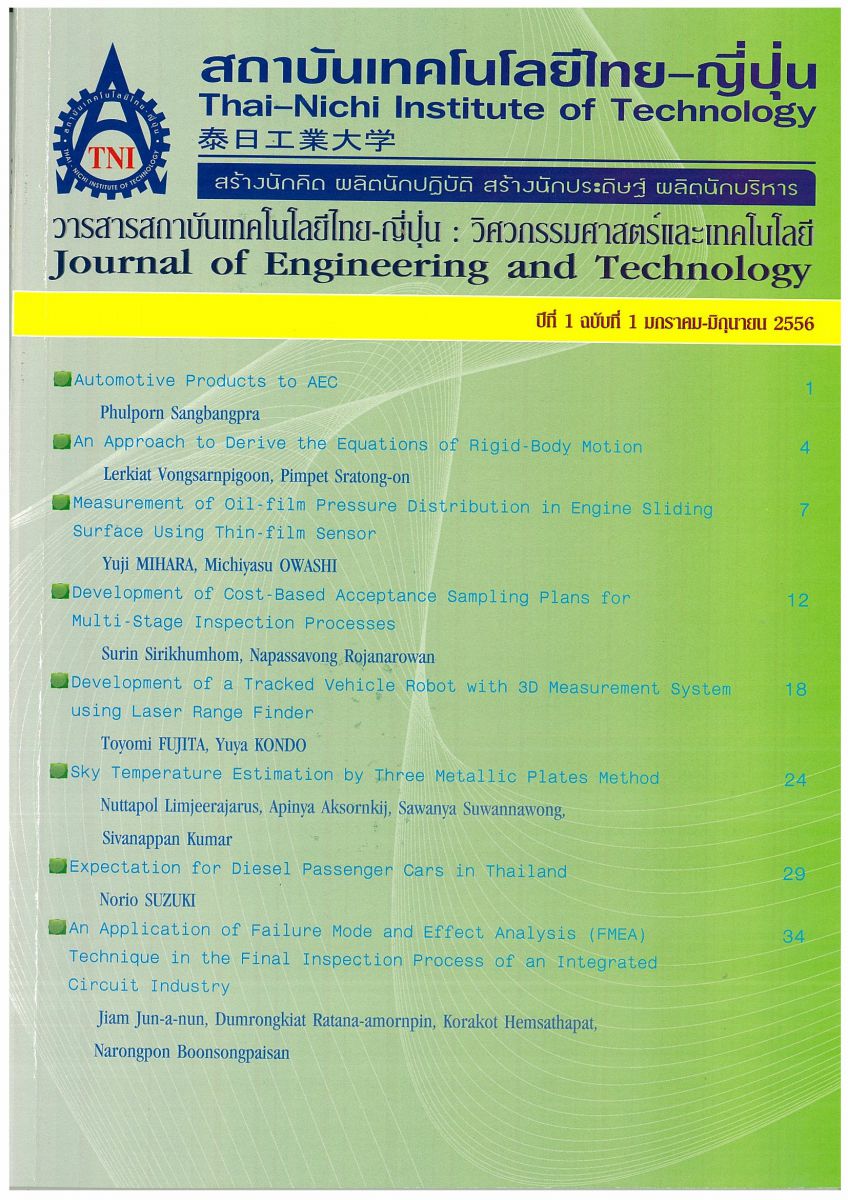An Application of Failure Mode and Effect Analysis (FMEA) Technique in the Final Inspection Process of an Integrated Circuit Industry
Main Article Content
Abstract
The objective of this study is to apply Failure Mode and Effect Analysis (FMEA) to reduce defects in the final inspection process of an integrated circuit industry. Team brain-storming cause-and-effect diagram and FMEA were utilized to investigate the quality of process. Then specialists further analyzed and evaluated level of severity, opportunity of occurrence, and opportunity of defect detection in order to calculate Risk Priority Number (RPN). Two major problems were considered for corrective actions. First problem occurred during machine process setup resulting in possible error in manually loading program by operator. Second problem occurred during loading device into machine process resulting in error in direction checking of tray chamfer. Proposed solutions were to utilize barcode scan on job order to automatically select program from the system, and to redesign instrument to protect wrong tray loading. The factory can benefit from having process guideline, controlling over quality factors, and ensuring the defect will not reoccur. Consequently, rework process was reduced from 20 case/month down to 10 case/month (50%). Cycle time was shortened from 2 hour/lot down to 1.5 hour/lot (25%). Defect was reduced from 2,600 part/million down to 1,300 part/million (50%). Productivity was increased from 1,500 unit/hour up to 1,875 unit/hour.
Article Details
Article Accepting Policy
The editorial board of Thai-Nichi Institute of Technology is pleased to receive articles from lecturers and experts in the fields of engineering and technology written in Thai or English. The academic work submitted for publication must not be published in any other publication before and must not be under consideration of other journal submissions. Therefore, those interested in participating in the dissemination of work and knowledge can submit their article to the editorial board for further submission to the screening committee to consider publishing in the journal. The articles that can be published include solely research articles. Interested persons can prepare their articles by reviewing recommendations for article authors.
Copyright infringement is solely the responsibility of the author(s) of the article. Articles that have been published must be screened and reviewed for quality from qualified experts approved by the editorial board.
The text that appears within each article published in this research journal is a personal opinion of each author, nothing related to Thai-Nichi Institute of Technology, and other faculty members in the institution in any way. Responsibilities and accuracy for the content of each article are owned by each author. If there is any mistake, each author will be responsible for his/her own article(s).
The editorial board reserves the right not to bring any content, views or comments of articles in the Journal of Thai-Nichi Institute of Technology to publish before receiving permission from the authorized author(s) in writing. The published work is the copyright of the Journal of Thai-Nichi Institute of Technology.
References
Somphop Talabkaew. FMEA application of methods to improve customer satisfaction. Search on March 7, 2009, from https://www.tpmconsulting.org/dwnld/article/tpm/ fmea.pdf.
Somchai Puajindanetr (2551). Potential analysis and impact damage. (documentation of learning). Bangkok: (N/A)
Kittisak Ploypanichchareon. (2551). FMEA Analysis of symptoms and disruption effects. 1st ed. Bangkok: Publishing TPA
Kittisak Anuraksakul. (2545). The analysis and reduction of waste in the process of forming automotive structural parts using techniques FMEA. Thesis (Industrial Engineering). Bangkok: Graduate School. Chulalongkorn University.
Kusuma Jirawongsawad. (2550). Applying FMEA and AHP to improving processes. African manufacturers need a case study: manufacturing ceramics coatings. Thesis (Industrial Engineering). Bangkok: King Mongkut Institute of Technology North Bangkok.
Department of Industrial Engineering. Faculty of Engineering. King Mongkut Institute of Technology North Bangkok. (2550). The failure analysis and effects (FMEA). Search on March 13, 2552, from https://www.kmitnbxmie8.com/index.php?lay = show & ac = article & Id = 412058 & Ntype =3
Chalermpon Lelaphatikul. (2540). Analysis and control of quality factors for the tyre industry. Thesis (Industrial Engineering). Bangkok: Graduate School. Chulalongkorn University.
Tanyaporn Tanaboonsombat. (2546). Defects analysis and reduction for side-temper automotive glass process by FMEA technique. Thesis (Industrial Engineering). Bangkok: Graduate School. Chulalongkorn University.
Nopnarong Sirisatien. (2550). Poka Yoke. (Seminar documentation). Bangkok: (N/A).
Nipon Chawanapranee. (2543). An applpication of FMEA & FTA techniques for electric cable design and development. Thesis (Industrial Engineering). Bangkok: Graduate School. Chulalongkorn University.
Piyawat Rattanasupar . (2545.) Standards in the manufacturing process, customize the color by color using analytical techniques of potential defects and impact. Thesis (engineering management). Bangkok: Graduate School. Chulalongkorn University.
Inthira Laosrimongkol. (2548). FMEA application guidelines to reduce waste products cast iron. Thesis (Industrial Engineering). Bangkok: Graduate School. Chulalongkorn University.
AIAG. (2008). Potential Failure Mode And Effects Analysis (FMEA). 4th ed. USA : AIAG - Automotive Industry Action Group.


